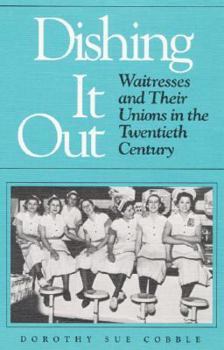Dishing It Out: Waitresses and Their Unions in the Twentieth Century (Working Class in American History)
(Part of the The Working Class in American History Series)
Select Format
Select Condition 
Book Overview
Back when SOS or Adam and Eve on a raft were things to order if you were hungry but a little short on time and money, nearly one-fourth of all waitresses belonged to unions. By the time their movement... This description may be from another edition of this product.
Format:Hardcover
Language:English
ISBN:0252018125
ISBN13:9780252018121
Release Date:September 1991
Publisher:University of Illinois Press
Length:327 Pages
Weight:1.25 lbs.
Dimensions:9.5" x 1.3" x 6.5"
Customer Reviews
2 ratings
A highwayscribery "Book Report"
Published by Thriftbooks.com User , 15 years ago
Caution to flirts, cads, and ladies' men: "Dishing It Out," will change the way you look at waitresses for forever. And if you think a book about waitressing falls into the hum-drum category, "Dishing It Out" demonstrates how a well-researched idea, presented with passion, can bring seemingly less-enticing topics to colorful life. Sometimes, subjects can appear devoid of interest because of their very neglect and let us note how Microsoft Works Word Processor spell-check doesn't recognize the expression "waitressing." But Dorothy Sue Cobble's book suggests that, to a certain degree, the rise and fall of waitress unionism traces our evolution (devolution?) as a country. highwayscribery first came across Cobble through "Lost Ways of Unionism: Historical Perspective on Reinventing the Labor Movement," one in a larger collection of essays entitled "Rekindling the Movement: Labor's Quest for Relevance in the Twenty-First Century,", wherein she challenged the widely held view that skilled craft unions of the American Federation of Labor were less progressive than the Congress of Industrial Organizations' mass unions. In her, "The Other Women's Movement: Workplace Justice and Social Rights in Modern America," Cobble posits that dominant feminist analysis passes over a generation of mid-century "labor women." Picking up on a theme developed in that book, Cobble writes that, in contrast to the later wave of feminists, waitresses did not want to be treated the same as the boys, rather, "They wanted equality and special treatment and did not see the two as incompatible." "Dishing it Out," kicks the can a little further down the path, by focusing on the specific craft. "The craft of waitressing has always been, she writes, "one of the principal jobs for women, it was distinguished by certain characteristics that enabled female servers to formulate and sustain a culture of solidarity at the workplace. Most female food servers shared share a similar racial and ethnic background. The relative ethnic and racial homogeneity of waitresses fostered group cohesion as it has for other groups of workers, men and women. In addition, more than women in other occupations, waitresses lived outside a traditional family setting and hence turned quite readily to their workplace community for friendship and support. If young and single, they often chose to live apart from their families, frequently residing with other waitresses in small apartments or rented rooms. The high proportion who were divorced, separated, or widowed lived alone, with friends, or with dependent relatives or children. Unable to rely financially on their family of origin or on a husband, waitresses were often primarily self-supporting and attached to the work force in a permanent fashion." Cobble fleshes out how these attributes lent themselves to a sorority-like adhesion that fostered unionization. The heyday of waitresses syndicates took root around the same time the larger movement
excellent! well researched and written.
Published by Thriftbooks.com User , 26 years ago
Cobble has written an invaluable history book about a large segment of the twentieth century workforce that would have otherwise been overlooked and forgotten. Waitresses have been ubiquitious and invisible at the same time. This book speaks to gender, class, ethnic, and work issues. It is written in a style that is informative AND interesting throughout. The historical research and organization of the book is superb. If you didn't know you were interested in this topic, the minute you start reading Cobble's book you will find out otherwise.






